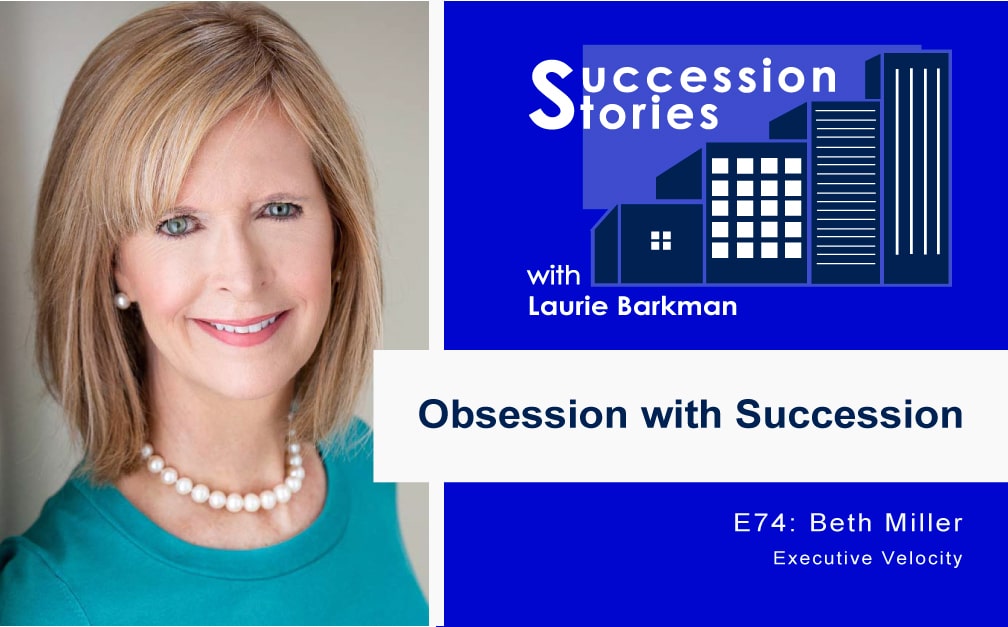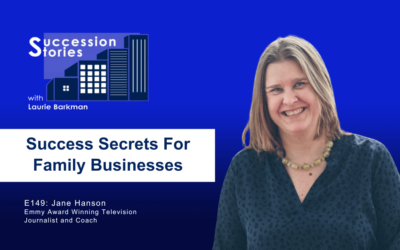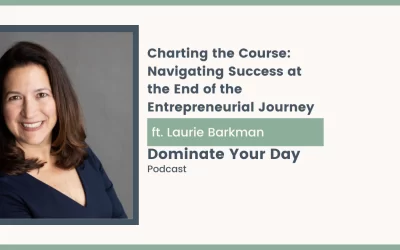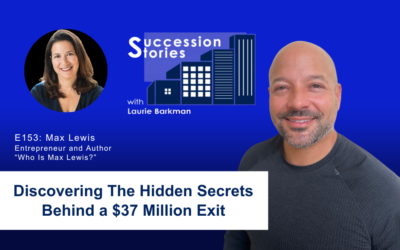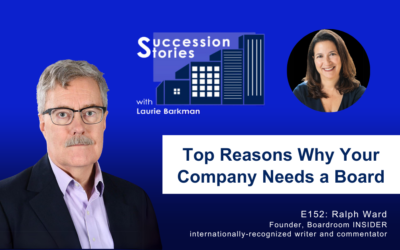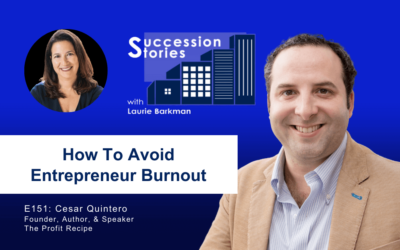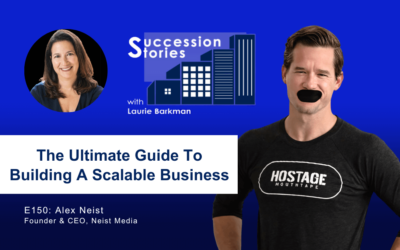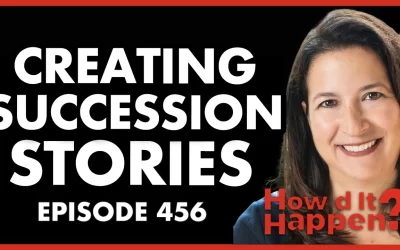100% of business owners will leave their business someday. Whether a business thrives after an owner leaves depends on your succession plan to ensure a smooth transition. How do you create a succession plan? What are the dos and don’ts? How can a well planned succession improve your business value? Listen in as Beth Miller returns to Succession Stories to discuss her book Replaceable: An Obsession with Succession to help you plan for a successful transition in your business.
Listen in to learn more about:
- Building a plan for life beyond your business
- What separates successful transitions from those that fail
- Why a succession plan should be an ongoing process
- Analyzing the gaps between your key people and key positions and developing your team in time
- How to communicate about your succession plan with your team
- Mapping out a competency ladder for your company for effective leadership
- Tools and resources to help you gauge your readiness to transition both at a personal and business level
Show Links:
Replaceable: An Obsession with Succession
Avoiding Succession Planning Mistakes – Beth Miller on Succession Stories E36
Connect with Beth Miller:
LinkedIn: https://www.linkedin.com/in/betharmknechtmiller
Website: https://executive-velocity.com/meet-beth-miller/
Transcript:
Your business will be more valuable if it is transferable. As a CEO or business owner, you should be replaceable in your organization. Yet only 50% of small businesses have a succession plan, impacting overall success and limiting potential. It takes more than an understanding of the importance of succession planning, it takes discipline. Beth Miller, an executive coach and succession expert, returns to Succession Stories to discuss her new book, Replaceable. Listen in for tips to develop the right succession plan for your organization.
Laurie Barkman:
Beth Armknecht Miller, welcome back to Succession Stories. You are the first person to come back for a part two. How about that?
Beth Miller:
Oh, well, I feel honored. Thank you so much, Laurie, I’ve been looking forward to chatting with you today.
Laurie Barkman:
You and I have so much to talk about. You are obsessed with succession and of course, the show is called Succession Stories. We met last year, you had reached out and we recorded Episode 36, you were on Episode 36, and we had a great conversation. We talked about issues surrounding succession planning and how business owners can avoid pressing mistakes. Since that time, you’ve turned your experience into a book, your second book, which is called Replaceable: An Obsession with Succession, so congratulations on the launch, and thank you so much for being here. I look forward to talking with you about the book.
Beth Miller:
Thank you, Laurie.
Laurie Barkman:
Let’s start, so let’s jump in. Why did you decide to write a book about succession?
Beth Miller:
Well, I was a Vistage chair for many years so I worked with small business owners during their succession, and through their succession, some of them that had very successful exits, while others not so successful, and so, during those lessons, I was thinking, “Gosh, you know, it’d be really great to be able to sit down and write my learnings from these great individuals,” so that other small business owners wouldn’t make the mistakes of some of the things that I saw, and follow the path of those individuals that really were successful in their exit. That was how I had the idea. It was in the back of my mind for several years, and then the pandemic hit, and I was like, “Wow, I’ve got some time now. Why don’t I start writing the book?” So I started, I think it was July of 2020, and it was launched last month in September.
Laurie Barkman:
It’s a labor of love.
Beth Miller:
Yes.
Laurie Barkman:
Now, I’m holding it up here for anyone watching the video on YouTube, they can see the book. One of the most important roles of a leader is to think about succession, because the reality is, 100% of us are going to leave our companies one day.
Beth Miller:
Yes.
Laurie Barkman:
So how do you set up your team, your family, your successors? How do you set it up for that transition? If a listener has listened to any other episode besides this one, they’ll have heard this from me, which is, look, transitions are going to happen, and change is going to happen, and so if we embrace that, and we try to be proactive in thinking about what those options might be, some of those options might include selling the company. I don’t say and advocate that they have to sell, but at least it certainly is an option and creating those options is really what it’s all about; having more options to choose from should lead to a better outcome, hopefully, and so for companies where the owner or the CEO is the most important person, that business, we call it a hub and spoke challenge, where they are the ones answering all the questions, they’re firefighting, and the business isn’t set up for success to transfer, It’s actually a worthless business.
Beth Miller:
That’s correct. Exactly.
Laurie Barkman:
Have you seen that happen where an owner just could not separate from the business soon enough, and ultimately, it closed or liquidated, or it just had a failed succession?
Beth Miller:
Yeah, in fact, in the book, I actually have a story. I start out with a story of two companies, one that did succession planning very successfully, and the other one that didn’t. The one that didn’t was really controlling a lot of what was going on in the business, and could never really see what life was going to look like after the business. That’s one of the major roadblocks I see. This was a family business, and I mentioned that I had been a Vistage chair. The group had worked with this individual for about a year saying, “Hey, you know, you’re getting older. You need to start planning your succession,” and he did but he didn’t. It wasn’t a strategic succession plan. He wasn’t developing his people like he should and sadly, I got a call on a Sunday morning that he had died of a heart attack. What happened was, 18 months later that company just shut down. There was nobody prepared to take over the business and it was really tragic.
Now the other guy was very purposeful about planning for succession, and had identified a high potential to take over and had started developing him. In fact, that individual’s actually in my Vistage group, so at the point where he actually sold his business, he was only working in the business one day a week and it wasn’t a company that needed him, so he actually got full value upfront. He had no earnout and it was an all cash deal, which is very unusual.
Laurie Barkman:
And desirable.
Beth Miller:
Yes, exactly.
Laurie Barkman:
For people who don’t know what an earnout is, it means that it’s a commitment from the seller to stay on board, typically for one year, two years, three years, and a lot of times, there’s financial milestones tied to the earnout. It could be on revenue, it can be on profit, it could be on other things. It’s advantageous for a seller to not have an earnout and to have an all out deal, so that is a good thing. We want to make our businesses able to thrive without us but yet, so many organizations do not have a succession plan and they don’t have an exit plan. We probably should talk about the distinction between the two. Let’s see your cat. Is that your cat?
Beth Miller:
[Laughing] Yes.
Laurie Barkman:
There he is.
Beth Miller:
His name is Mr. Bates for Downton Abbey but the problem is, he’s not quiet, like Mr. Bates. [Laughs]
Laurie Barkman:
[Laughs] Well, he’s welcome to be part of the show so you can have him on your lap.
Let’s talk about that. Back to the question, which is, why do so few organizations have succession plans in place that’s written down and formalized?
Beth Miller:
I think a lot of it has to do with the owner and that, the owner is fearful. Really. I mean, they would never admit it, but they built their business, their life has revolved around the business, and they don’t have a plan for after the business, and I talk about that in the book. That’s one of the big roadblocks; if you as a business owner, if you don’t understand what life looks like after you sell, then you’re less likely to really be driving that succession plan and the succession plan should be something that is ongoing. It’s not, it’s not like an exit plan. Succession planning is all around making sure you’ve got the right people in the right seats at the right time and that means you need to be integrating that succession plan with your annual planning and so it should be refreshed every year. That’s something that a lot of smaller companies do not do.
Laurie Barkman:
Right? They’re not writing it down. It’s in their head.
Beth Miller:
Yeah.
Laurie Barkman:
If it’s in your head, it’s not really a plan.
Beth Miller:
Exactly.
Laurie Barkman:
You’re not holding yourself accountable to it, and no one else is holding you accountable to it. That’s really important. There’s a lot of transitions happening in the marketplace. We hear about the high profile ones, Jeff Bezos and others, but there’s also… there’s retirements, some people are retiring, some people are starting other companies, they have that vision of what they want to do next, as you point out, which makes them more satisfied, but there’s also a pretty frothy M&A market so there’s a lot of activity there too, and by the way, just to mention, do you love the show Succession? Do you watch it?
Beth Miller:
You know what, I don’t watch a lot of TV to be honest.
Laurie Barkman:
Okay, well, it’s a really great show.
Beth Miller:
Maybe I should check it out.
Laurie Barkman:
Check it out, because it is about this very high profile, successful family, they’re doing lots of things wrong. Maybe that’s what we’ll do if you come on a third time; dissect that show, ask can that company be saved? Can the family be saved? All right, well, we’ll save that for another time. So, if a company has a next generation, which could be a next generation of managers, or it could be related parties, it could be things like that but they’re not ready yet, what’s an approach to bridge the gap from now to when they are ready?
Beth Miller:
Well, the first step is to really analyze what the gaps are. You need to understand what your key positions are versus the key people and determine, “Okay, are those key people in the key positions? And if so, what are those skills or behaviors that need to be developed, so that they’re ready in time for that next position?” A lot of my book is around development and how do you make sure that you can identify your high potentials, and make sure that you’re developing them in a timely manner, so that they’re prepared. There’s a lot of research, especially with millennials, that if they’re not getting developed, they’re going to leave.
The idea of a succession plan, if you can communicate that you’ve got a succession plan in your organization, you don’t have to–you’re not naming names–you’re just saying, “Hey, we are committed to a succession plan, which means developing the people within the organization to be ready for when our company is larger, to take on more responsibilities.” You’re not committing to stepping away, you’re committing to your employees, and developing them.
Laurie Barkman:
Is this something for companies that are a certain size, typically see maybe 40 and above?
Beth Miller:
Usually, I look at it as the 30 employees and above. I mean, if you’ve only got 10 people going through this process, it’s gonna be overkill. But if you’ve got 1000 people or 5000 people, this might be a little light, the process, especially when it comes to competencies, and defining what competencies are critical to a position. Large companies will spend millions of dollars on competency models and they will have to update them every year. What I do is, I look at it as a competency ladder and there’s two levels.
The first is core competencies for your organization that all employees should have, and those competencies align with your values so if you’ve got a value, you should have multiple values, what behaviors support those values? Then what are the competencies around those behaviors? Then there’s a second level, and those are the leadership competencies. I don’t say, “Hey, go and create competencies for every job.” It’s competencies for single contributors, and then leaders.
Laurie Barkman:
This is typically the owner, the CEO looking at his or her organization, from a top down perspective.
Beth Miller:
Right.
Laurie Barkman:
Do you also see that or do you get into conversations with people about their board and board succession?
Beth Miller:
I did not address that at all in this book. It’s specifically around the organization itself. The board’s a little different in the fact that you’re not getting involved with their development. They’re their people from the outside. You could use some of the techniques that I talked about, as it relates to boards, like key positions, for instance. If you’ve got, if you feel like you need somebody that’s really connected to the financial world, or connected to some of your industry well, obviously, if somebody is rolling off, you’re going to want to replace them with something similar to that, but no, it’s mostly around the organization.
Laurie Barkman:
So it can work for organizations of a larger size where you have a death on the bench, you can think of this skills matrix for your board or your advisors. But then also, I think it’s important to acknowledge that this is a journey. You were saying that it is not a one and done even in smaller organizations. I have a client that is under 20 people, they’re probably 15, have some really key lieutenants and if those people left, they might not have anyone in the organization who could step in. So while we say that there should be this more formalized process, it’s probably worth saying, for the smaller organizations, especially if they are envisioning a transition in the future, they are going to have more of an acute problem, because there’s just less people, so it is pretty important there too, isn’t it?
Beth Miller:
Especially those key positions. If you’ve got a salesperson who has strong relationships with your clients, if that person should exit, how are you going to keep those relationships without them disappearing with your salesperson? Now, granted you can have all the legal paperwork related to that individual not taking your clients, etc. But eventually that will run out and you might have a year or two, but you need to really be careful from a risk perspective of those key employees leaving. If you’ve got 10 people, for instance, well, one of the things you can do is cross train so that you’ve got some sort of backup. But yeah, the smaller the organization, the riskier it is.
Laurie Barkman:
It is. Let’s go back to the idea around the connection and the difference between succession planning and exit planning. Now, in your story, as you laid out, there are some paths these characters are taking and I guess in real life, too, and I know these characters are probably based on some amalgamation of clients that you’ve had.
Beth Miller:
Yes.
Laurie Barkman:
People that you anonymize of course. When it comes to exit planning and being able to create that vision as an owner, what your life might look like after the sale or after you’ve retired from your business, either way, exit in the sense of, you’re not part of the company anymore, why do you think it’s so difficult for people to think about what’s next?
Beth Miller:
The unknown, if they haven’t experienced it in the past. I think that there are some individuals that are more prone to looking into the future, while there are others that are more about the here and now, so those individuals that look more into the future and have a good support system around them, if they’re already involved, for instance, with some other activities, they could get more involved with those activities. The people that have lived so much for their company, are the ones that have a harder time letting go, at least in my experience.
The individual Dan, in the book, Dan is somebody who had some some activities, but didn’t have as much time to do them so he expanded those and then his personal situation was changing, where he was becoming a grandfather, so he wanted to spend more time so there was a personal reason for that as well. He was just very committed to making sure that not only was the exit good for him, but for his key employees as well. He had a very nice cash windfall, but his key employees also benefited from the sale as well.
Laurie Barkman:
I have the same ethos of when I work with clients, that we need to talk about the business readiness, we need to talk about the personal readiness. A lot of times the personal readiness is the afterthought, but I try to bring it forward. If they’re talking with me, they probably already have decided at some level that they want to start preparing their business for sale or preparing it for, let’s say, an internal succession or some sort of exit on the other side; what’s coming in the next three years, five years, or one year.
We do have an assessment, and you probably have tools too, but we use an assessment, we call it the PREScore, which is personal readiness to exit. It boils it down into different attributes, like four key drivers and so they dovetail very nicely with what you’re saying, and we can measure where they are in that continuum of readiness, and then talk about an action plan. What are those questions they need to be exploring?
I have a husband and wife that are clients, and the husband’s the owner of the business, but the wife works in the business and of course, she’s involved day to day and she’s leaning towards being more ready than he is for some reasons, and it’s been interesting to have that conversation too. A lot of times, I think the value that advisors can have with a client that’s contemplating is being able to draw out these uncomfortable, uncertain kinds of things. We’re not licensed therapists, but a lot of it is fear; we’re getting older or, fear of change so this squishy place, this uncertain place. I think it is valuable to have a book like yours to be able to have the time to explore, but it’s also helpful to talk to someone.
Beth Miller:
Yes. Most of my work is asking the questions that they’ve never asked themselves, or they’ve asked themselves, but it’s never been in the forefront of their mind, and then it gets them to self-reflect on what could be versus what is.
Laurie Barkman:
Well, I guess, just share a little high level about the book. You talked about the characters in the book, but I know you also have a lot of tools in here, so maybe just give the cliffnotes if possible. If someone wants to find your book, what would be a good reason for them to go get it on Amazon or wherever they’re going to buy it?
Beth Miller:
Well, I think if you’re a business owner, whether you’re 40 years old or 60 years old, it really doesn’t matter as it relates to succession planning. Succession planning is not just about you and your company, but it’s about the people internally. If you are focused on creating a path for the company as well as creating a path for the employees, hopefully, that will increase retention and right now we’ve got a huge talent war going up there, worse than we’ve ever had in the last 10-15 years, and we’ve been talking about talent war for a long time but when I talk to business owners now, the two things I talk about as the biggest challenge are talent, and supply chain. So if the employees know that there’s a succession plan, and that they’re being developed as part of that plan, you’re more likely to retain them and retain them for a longer period of time.
Laurie Barkman:
You mentioned that earlier. I think that’s a really good point about millennials. Millennials tend to be mission driven and purpose driven and you talked about tying core values to behaviors. I was just with a client over the last couple days doing strategic planning and while this company is not a new company, they’re not a startup, they’ve been around over 10 years, they’ve had different versions of core values and know what happens there; people start to do eye rolls.
Beth Miller:
Exactly.
Laurie Barkman:
“Oh, no. Not again.” So with this leadership team, which is a younger team in terms of tenure, not necessarily age, but tenure, it was really important to talk about that. How do we bring these values to life? We did. We talked about that as an example with your people, you’re going to look for the behaviors and identify when someone is out of expectations, you now have something to come back to and using it in succession planning is such a powerful way to demonstrate why they matter.
Beth Miller:
Also in the book, I have a chapter on hiring, because eventually, you are going to have to hire people externally, because you don’t have a person to succeed another person for some reason, and, to integrate those core values and behaviors into the the interview process, so that you’re getting the right people on the bus.
Laurie Barkman:
For sure. Well, is there anything else about the book that you’d like us to know?
Beth Miller:
I think that I’ve tried to condense it, meaning there’s a lot of how to. There is a story, but it’s really a lot of how to, so if you are somebody who is going through business planning right now, and want to include succession planning in the process, this is a great book to use. It will help you to determine whether you’re ready for succession planning. Do you have the infrastructure? And if not, how do you fill those gaps while you’re developing a succession plan? Because there are things like development plans. There are a lot of small companies that don’t do development plans and don’t have career conversations but those are things that you could easily create as part of your succession planning process.
Laurie Barkman:
Let’s talk about the big why. Before I ask you for your favorite quote, we’re going to talk about the big why, and the big ‘why’ here is, you will have more peace of mind. And Probably, if you’re going to continue to run your business for the next 10 years, 15 years, having the bench of people around you, the processes to support you as a business owner, is not only going to make your company more valuable, but it’ll probably make your work-life balance more happy, being happier in that in that environment. Then also, that bigger picture of creating more enterprise value, I think, is certainly, to underscore Simon Sinek, start with why. That’s the biggest one. I love to ask everyone, and because you’ve been on the show, you’ve already shared a favorite quote, so now I’ve asked you to choose a different quote. What is a quote you’d like to share?
Beth Miller:
I have quotes in my book, so the one that I wanted to use today is from Peter Drucker, and it’s ‘to be a manager requires more than a title, a big office and other symbols of rank. It requires competence and performance of a high order.’
Laurie Barkman:
Competence of a high order.
Beth Miller:
Yes, exactly.
Laurie Barkman:
So if my son doesn’t take out the trash, I can say he does not have competence of a high order.
Beth Miller:
[Laughs]
Laurie Barkman:
I’m gonna use that. I like that. Peter Drucker.
Thank you very much for including me in the book. You asked me to do an acknowledgement of it, and I really appreciate that. Again, if people pick it up, you’ll see a quote from me in there in the beginning and I do think it’s a really valuable read. I do encourage everyone to check it out. It’ll help give you some tools, how to, and also, if folks want to find this out, what’s a great way to get in touch with you? Or to find the book?
Beth Miller:
Well, the book is on Amazon so just type in replaceable and obsession with succession and you’ll find it there. It’s both a soft copy as well as a hardcopy, and then to find me, you can find me on my website, which is executive-philosophy.com or on LinkedIn, and you would put in ‘Beth Armknecht Miller’. I think there’s a bunch of Beth Millers.
Laurie Barkman:
We all have our uniqueness.
Beth Miller:
That’s right, exactly.
Laurie Barkman:
Well, one of the other things, and Beth, we talked before we started recording. I’m a little bit apprehensive to say this and share it, but you’re giving me the courage to do so. I am going to write a book as well. I have not officially said it, but now I’m saying it on air and everyone’s gonna hear me saying it and so now I’m going to hold myself accountable to it. So I really appreciate you showing me the way that this is going to be. You make it look so easy but it’s going to be fun.
Beth Miller:
Yeah, and if you ever need some tips on the process, please reach out to me.
Laurie Barkman:
Absolutely. So more to come on that for me. Beth, thank you so much for being on the show, talking about your book, Replaceable: An Obsession with Succession, and of course, sharing your knowledge. I really appreciate it.
Beth Miller:
Well, thank you for the invitation. I’ve really enjoyed it, Laurie.

